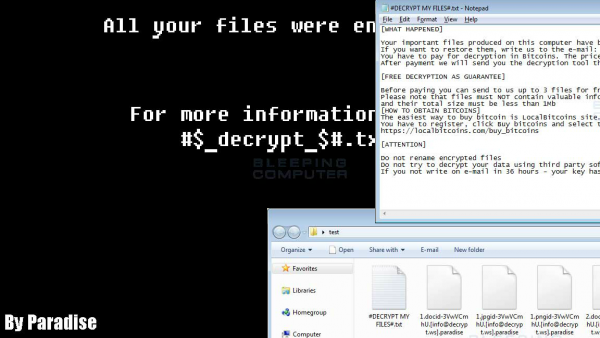The infection name is a conventional designation. Most of the users concerned call it Paradise ransomware. That is because of what they see, the extension added at the end of any file.

The Paradise ransomware appends the same-name string at the end of any item it hacks. The attack it deploys leverages RSA cipher. This is a strongest, military-grade encryption algorithm. Brute-forcing, even by means of the most powerful computer, is to no avail: experts predict this would take longer than one is likely to live.
On the other hand, the encryption takes time. That is a chance for the victim’s early response. One may detect and terminate the process before it reaches critical files.
Distribution of Paradise ransom trojan is delegated to affiliates as the ransomware is available as a service. Ransomware as a Service (RaaS) is common definition. It refers to a scheme whereby the developers do not propagate their malware directly. They make the virus available to the distributors withdrawing a commission from each ransom payment as agreed. As the RaaS campaign is deploying the developers do not idle. They support the installation, operation of the ransomware and the ransom transaction via remote Command-and-Control Center.
The distributors are free to drop the virus the way they find appropriate. In the wild, examination of the history derived from hacked computers suggests the Remote Desktop control is a popular gateway. Such method of installation implies the device is controlled remotely. An installed copy of the infection regains the administrative privileges, so it terminates the remote control routine.
The virus modifies filenames as well. Each is subject to modification in line with the following template: filename.string id-[affiliate_id].[affiliate_email].paradise. As the rogue retains true file name and allows free decryption for three files, a victim may go ahead and decrypt at least three critical items.
Paradise decryption is strong, but not flawless. There is a good chance to recover the data with free tips and tools outlined below.
Automatic removal of Paradise Ransomware
The benefits of using the automatic security suite to get rid of this infection are obvious: it scans the entire system and detects all potential fragments of the virus, so you are a few mouse clicks away from a complete fix.
- Download and install recommended malware security suite
- Select Start Computer Scan feature and wait until the utility comes up with the scan report. Proceed by clicking on the Fix Threats button, which will trigger a thorough removal process to address all the malware issues compromising your computer and your privacy.
Restore files locked by Paradise Ransomware
new Locky variant aka Paradise Ransomware represents a unique category of malicious software whose attack surface reaches beyond the operating system and its components, which is why removing the virus itself is a part of the fix only. As it has been mentioned, it encrypts one’s personal information, so the next phase of the overall remediation presupposes reinstating the files that will otherwise remain inaccessible.
-
Launch data recovery software
Similarly to the rest of its fellow-infections, Paradise Ransomware most likely follows an operational algorithm where it erases the original versions of the victim’s files and actually encrypts their copies. This peculiarity might make your day, because forensics-focused applications like Data Recovery Pro are capable of restoring the information that has been removed. As the virus further evolves, its modus operandi may be altered – in the meanwhile, go ahead and try this.
-
Take advantage of Volume Shadow Copy Service
This technique is based on using the native backup functionality that’s shipped with Windows operating system. Also referred to as Volume Snapshot Service (VSS), this feature makes regular backups of the user’s files and keeps their most recent versions as long as System Restore is on. Paradise Ransomware hasn’t been found to affect these copies therefore the restoration vector in question is strongly recommended. The two sub-sections below highlight the automatic and manual workflow.
- a) Use Shadow Explorer
Shadow Explorer is an applet that provides an easy way of retrieving previous versions of files and folders. Its pro’s include an intuitive interface where the computer’s entire file hierarchy is displayed within one window. Just pick the hard disk volume, select the object or directory to be restored, right-click on it and choose Export. Follow the app’s prompts to get the job done.

- b) Use file properties
Essentially, what the above-mentioned Shadow Explorer tool does is it automates the process that can otherwise be performed manually via the Properties dialog for individual files. This particular approach is more cumbrous but just as effective as its software-based counterpart, so you can proceed by right-clicking on a specific file, which has been encrypted by Paradise Ransomware, and selecting Properties in the context menu. The tab named Previous Versions is the next thing to click – it displays available versions of the file by date of the snapshot creation. Pick the latest copy and complete the retrieval by following the prompts.

-
Data backups work wonders
Ransomware like Paradise Ransomware isn’t nearly as almighty and destructive in case you run regular file backups to the cloud or external data media. The virus itself can be completely removed in a matter of minutes, and the distorted information can then be just as easily recovered from the backup. Luckily, this is a growing trend, so ransom Trojans are hopefully going to become less subversive in the near future.
Verify thoroughness of the removal
Having carried out the instructions above, add a finishing touch to the security procedure by running an additional computer scan to check for residual malware activity
